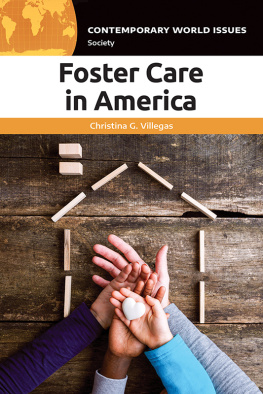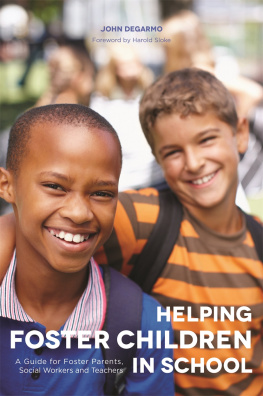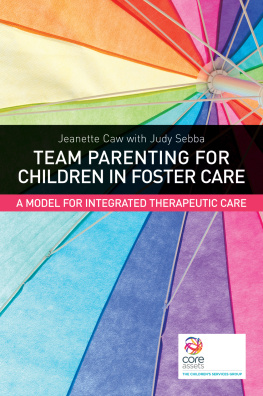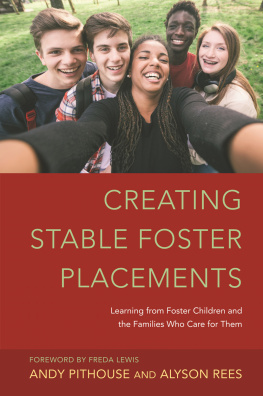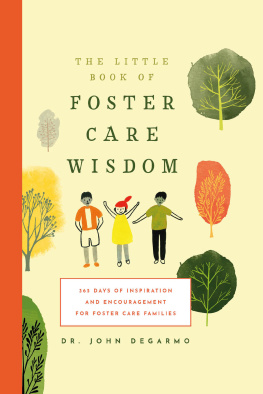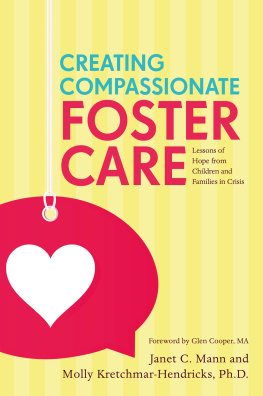I would like to thank Robin Tutt and Kevin Hillstrom at ABC-CLIO, who assisted me in various stages of this project. Thanks also to Martha Elwell, who reviewed drafts of a few of the chapters. I am additionally thankful to Brian Janiskee, chair of the Political Science Department at California State University, San Bernardino, for his professional support and mentorship and to Marilyn Gareis, the political science administrative support coordinator, for her assistance in various administrative tasks.
In the spring of 2020, I conducted an independent study on the foster care system with several undergraduate political science students at California State University, San BernardinoJavier Cordova, Jaymie Gonzalez, Alexandra Janiskee, and Keonte Jefferson. I am grateful for the unique insights they each provided in their discussion and research of the topic.
I am forever indebted to Diana Hayes for her invaluable mentorship. She convinced my husband and me to become foster parents, and she offered essential guidance and support as we fostered and eventually adopted our four beautiful children.
Above all, I am grateful to my husband, Manuel, and our children, Alexander, Anna, Izabella, and Sophia, for their support and for the profound joy they bring to my life.
About the Author
Christina Villegas, PhD, is an associate professor of political science at California State University, San Bernardino. She has written a variety of articles and books on topics related to the American founding, the U.S. Constitution, and public policy.
The term foster care refers to the juvenile dependency system intended to serve neglected, abused, and abandoned children who need to be either temporarily or permanently removed from their families of origin. Today, the system serves more than 670,000 children a year, and on any given day, over 400,000 of the nations children are in some form of foster care (Childrens Bureau 2020). While the concept of out-of-home care for abandoned or maltreated dependent children has existed in some form since the nations founding, the provision of that care looked very different in Americas early years compared to the complex government-run juvenile dependency system that exists today. This chapter provides a brief overview of the current structure and operation of foster care in America and outlines the historical development of the American foster care system, with a specific focus on the various federal statutes adopted to govern and influence state practices.
Foster care in America has never been and is still not a national system. Under the U.S. Constitution, the federal government was given legislative authority over specific areas of policy, and the 10th Amendment left all remaining powers to the states or to the people. These reserved powers, commonly referred to as the police powers, cover a wide range of policy areas, including the health, safety, morals, and general welfare of residents. Under this broad policy umbrella, states pass laws governing law enforcement, punishment for civil and criminal offenses, marriages, contracts, education, child welfare policy, and other societal areas. Today, the federal government primarily influences the child welfare system through the provision of technical assistance and funding to states and private agencies. The funding is generally contingent on the states and agencies using the funding in a way that is consistent with federal law. Such federal child welfare policy is generally administered by the Childrens Bureau, a branch of the Administration on Children, Youth, and Families (ACYF) within the Department of Health and Human Services (HHS). The federal government has also increasingly governed state policy in an effort to ensure compliance with the U.S. Constitution and civil rights laws.
Despite increased federal involvement and oversight over the past several decades, the states still retain control over the administrative framework for child welfare within their borders. Consequently, the operation and delivery of programs and services vary from state to state and even from locality to locality. At the state level, child welfare services are generally administered in one of three ways (CWIG 2018b). Most states operate a centralized administrative system run by the state government through its health and human services department or by an independent state-level child and family services agency.
Nine statesCalifornia, Colorado, Minnesota, New York, North Carolina, North Dakota, Ohio, Pennsylvania, and Virginiahave decentralized county-administered systems. Under such systems, county-level administrators submit a plan for how they will provide services to meet the needs of the region within the bounds of state and federal guidelines. The final form of child welfare service administration utilized by several states is a hybrid system in which the state government directly supervises and finances services, but county governments have significant influence over the funding and implementation of programs.
Under all three administrative systems, a variety of local agencies typically work together to serve those within the system. Public agencies often contract with and rely on private agencies and nonprofit community organizations to provide services related to family preservation; foster family recruitment, training, and support; mentorship for children and families; mental health care; substance abuse treatment; parenting skills classes; employment, housing, and financial assistance; and more. The process of placing children in care and working toward reuniting them with their families or finding a permanent placement for them elsewhere also requires the involvement of the state court system and sometimes local law enforcement.
The process through which children are placed in foster care is for the most part uniform across the country (CWIG 2020). About a third of children enter foster care because of delinquent behavior or because of the absence of their parents resulting from illness, death, or disability. Some parents voluntarily relinquish their children if they believe they can no longer care for them.
Typically, however, children first become involved with the child welfare system through a report of suspected child maltreatment, which may include abuse, neglect, or abandonment. Maltreatment that qualifies as child abuse and neglect is defined in both federal and state laws. The federal government provides guidance to states by setting a minimum standard definition of child abuse andneglect that states must adopt to be eligible for federal funding.
The federal Child Abuse Prevention and Treatment Act (CAPTA), as amended in 2010, defines child abuse and neglect as any recent act or failure to act on the part of a parent or caretaker, which results in death, serious physical or emotional harm, sexual abuse or exploitation, or an act or failure to act which presents an imminent risk of serious harm (CWIG 2019). The 2015 Justice for Victims of Trafficking Act expanded CAPTAs definition of child abuse and neglect and sexual abuse to include a child who is identified as a victim of sex trafficking or other severe forms of trafficking in persons.
States can expand on CAPTAs definition of child maltreatment in both their criminal and civil laws. Whereas criminal law definitions provide grounds for arrest and prosecution in criminal courts, civil law definitions determine the grounds for the reporting obligations of individuals and the required intervention by state and local child protection services (CPS) agencies and civil courts. Child welfare agencies typically do not intervene in cases of harm caused by acquaintances or strangers because these cases generally involve criminal charges and are handled by law enforcement.

